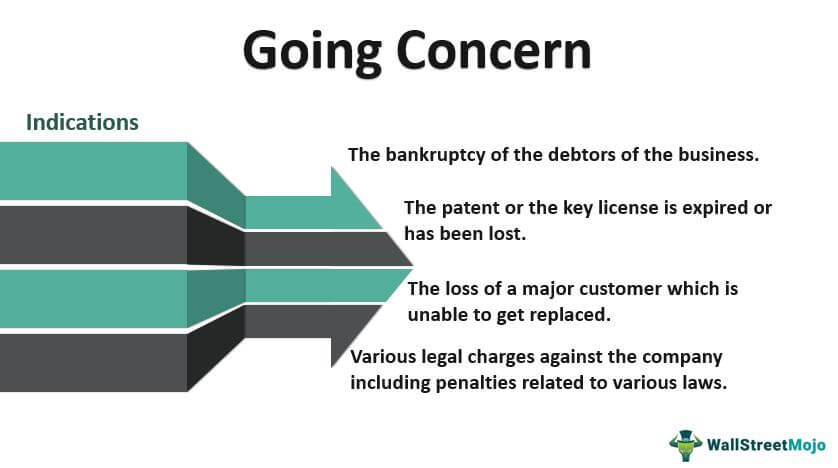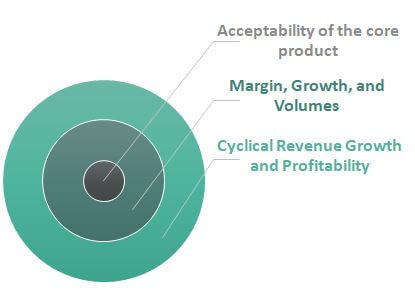Financial Statements Reflect the Assumption That the Business Continues Operating
Meaning of Going Concern
The Going Concern is an assumption made in financial statements that a company will not go bankrupt in the foreseeable future—usually referring to a period of 12 months. It is a fundamental accounting principle.
In other words, a gong concern will continue to exist in the long run, with no intention to shut down. There is no immediate uncertainty. When management considers such assumptions inappropriate, financial statements are prepared based on a break up basis.
Table of contents
- Meaning of Going Concern
- Going Concern Explained
- Going Concern Example
- Example #1:
- Example #2:
- Importance
- Indicators of Going Concern Problems
- Frequently Asked Questions (FAQs)
- Recommended Articles
- A going concern is an accounting assumption that a business will continue its operations for the foreseeable future. It is reflected in the financial statements of the company.
- The continuity of a business is determined by positive solvency position and enterprise values.
- According to Generally Accepted Accounting Standards (GAAS), the going concern assumption is a crucial parameter for ascertaining business longevity.
- Alarming signs that question the continuity of a business include low liquidity, decreasing market share, poor credibility, lawsuits, business losses, employee turnover, and outdated product itinerary.
Going Concern Explained

You are free to use this image on your website, templates, etc, Please provide us with an attribution link Article Link to be Hyperlinked
For eg:
Source: Going Concern (wallstreetmojo.com)
The going concern assumption is a fundamental accounting concept, similar to Consistency Principle According to the Consistency Principle, all accounting treatments should be followed consistently throughout the current and future periods unless compelled by law to change or the change provides a better accounting presentation. This concept prevents accounting fraud and ensures that financial statements are comparable across historical periods. read more and accrual assumption Accrual Accounting is an accounting method that instantly records revenues & expenditures after a transaction occurs, irrespective of when the payment is received or made. read more . According to this principle, financial statements are prepared, assuming the company intends to continue operations for the foreseeable future and has no motive or need to shut down.
On the other hand, if a company intends to close operations, financial statements will reflect such an intent—the company must disclose it. Unless disclosed, it is assumed by default that the company will realize its assets and settle its liabilities Liability is a financial obligation as a result of any past event which is a legal binding. Settling of a liability requires an outflow of an economic resource mostly money, and these are shown in the balance of the company. read more .

You are free to use this image on your website, templates, etc, Please provide us with an attribution link Article Link to be Hyperlinked
For eg:
Source: Going Concern (wallstreetmojo.com)
Although the going concern assumption holds no place in the Generally Accepted Accounting Principles (GAAP GAAP (Generally Accepted Accounting Principles) are standardized guidelines for accounting and financial reporting. read more ), it is recognized by Generally Accepted Accounting Standards (GAAS). GAAS considers this principle a crucial parameter for determining the longevity of a business.
So, when managements consider such an assumption inappropriate, they prepare financial statements using the breakup basis. The breakup basis reports assets based on the amount that is likely to be realized from the sale and liabilities—the net realizable value Net Realizable Value is a value at which the asset may be sold in the market by the company after deducting the expected cost of selling the asset in the market. It is a crucial metric for determining the value of a company's ending inventory or receivables. read more . For example, seasonal businesses like firecracker companies opt for the breakup basis.
Going Concern Example
Let us understand the application of this principle using examples.
Example #1:
AB Ltd. is a construction company that incurred a loss of $700,000 in a housing project— due to government stay and legal action. As a result, the company missed five installments of debt Debt is the practice of borrowing a tangible item, primarily money by an individual, business, or government, from another person, financial institution, or state. read more worth $60,000 (total non-repayment in 5 years).
The company lost its creditworthiness Creditworthiness is a measure of judging the loan repayment history of borrowers to ascertain their worth as a debtor who should be extended a future credit or not. For instance, a defaulter's creditworthiness is not very promising, so the lenders may avoid such a debtor out of the fear of losing their money. Creditworthiness applies to people, sovereign states, securities, and other entities whereby the creditors will analyze your creditworthiness before getting a new loan. read more in the debt market; it was on the verge of insolvency—bankrupt within 1.5 years. Before this situation, it was considered a going concern by the auditors An auditor is a professional appointed by an enterprise for an independent analysis of their accounting records and financial statements. An auditor issues a report about the accuracy and reliability of financial statements based on the country's local operating laws. read more and accountants.
Example #2:
Let us assume Douglas purchased a manufacturing plant & equipment for his business by paying $400,000 out of the $500,000 investment. He also paid installation expenses An expense is a cost incurred in completing any transaction by an organization, leading to either revenue generation creation of the asset, change in liability, or raising capital. read more , amounting to $2,000. If he is still willing to continue his business, his financial position will be as follows:

If Douglas decides to sell the manufacturing plant and equipment, he might get more or less than $402,000, which will change his financial position.
However, when we consider the concept of going concern Going Concern concept is an accounting principle which states that the accounting statements are formulated with a belief that the business will not be bankrupt or liquidated for the foreseeable future, which generally is for a period of 12 months. read more , such a change in asset value will be ignored in the short run A Short Run in economics refers to a manufacturing planning period in which a business tries to meet the market demand by keeping one or more production inputs fixed while changing others. read more . The principle highlights the assumption that companies intend to keep assets and generate profits in the future—assets won't be sold in between.
Therefore, the change in value is not realizable; Douglas and his company must not consider the going concern assumption. They must opt for the breakup basis.
Importance
The going concern assumption is crucial for the companies due to the following reasons:
- Primarily, it presumes that the firm will remain functional for an infinite period and has no liquidation Liquidation is the process of winding up a business or a segment of the business by selling off its assets. The amount realized by this is used to pay off the creditors and all other liabilities of the business in a specific order. read more plans.
- Also, it represents the financial stability of the organization and its efficiency in meeting long-term liabilities.
- It increases the creditors' trust in the business entity—helps the firm, secure finance, overdraft Overdraft is a banking facility that offers short-term credit to the account holders by allowing them to withdraw money from their savings or current account even if their account balance is or below zero. Its authorized limit differs from customer to customer. read more facility, and credit.
- Moreover, it is necessary for ascertaining the depreciation offixed assets Fixed assets are assets that are held for the long term and are not expected to be converted into cash in a short period of time. Plant and machinery, land and buildings, furniture, computers, copyright, and vehicles are all examples. read more .
Indicators of Going Concern Problems
The following red flags indicate that a company is unable to continue as a going concern:
- Negative Trends: Decrease in sales, financial ratios Financial ratios are indications of a company's financial performance. There are several forms of financial ratios that indicate the company's results, financial risks, and operational efficiency, such as the liquidity ratio, asset turnover ratio, operating profitability ratios, business risk ratios, financial risk ratio, stability ratios, and so on. read more , increase in costs, and recurring losses signal that the firm may not be solvent in the future.
- Employee Turnover: Loss of key managerial personnel, skilled staff, labor hardships, or strikes are red flags.
- Poor Liquidity Ratios: Declining liquidity and insufficient financing alternatives hint toward a possible bankruptcy Bankruptcy refers to the legal procedure of declaring an individual or a business as bankrupt. read more .
- Legal and Regulatory Matters: Legal charges against the company or penalties for breach of law is a serious red flag.
- Recurring Trading Loss: Businesses risk insolvency when long-term debtors announce bankruptcy.
- Loss of Patent: Losing a license or patent raises serious concerns for investors and shareholders A shareholder is an individual or an institution that owns one or more shares of stock in a public or a private corporation and, therefore, are the legal owners of the company. The ownership percentage depends on the number of shares they hold against the company's total shares. read more .
- Non-Repayment of Loan: Loan defaults are a common risk associated with any business. It is a vicious cycle; firms that desperately need financing end up with the worst credit ratings—they are unable to sanction further financing.
Frequently Asked Questions (FAQs)
What is a Going Concern?
It is an accounting assumption that defines the longevity of a business operation. By default, financial statements reflect this assumption. Unless the company discloses, it is assumed that it possesses adequate assets for fulfilling long-term liabilities.
What does it mean when a property is sold as a going concern?
It refers to properties sold for income-generating activities—on the registration date. Also, both property sellers and buyers must have VAT registration—registered as vendors. On such a transaction, the VAT charged is 0%. Also, the transaction should involve all the related assets that facilitate income generation.
What are some going concern red flags?
Warning signs include falling market share, poor creditworthiness, employee turnover, low liquidity, lawsuits, excessive business loss, and inability to innovate.
Recommended Articles
This article has been a guide to Going Concern Assumption and its meaning. Here we discuss Going Concern definition, accounting principles, audits, basis, values, and examples. You can learn more about it from the following articles –
- Internal Audit Definition
- 5 Types of Financial Ratios
- Materiality Concept
- Internal Audit vs External Audit
Source: https://www.wallstreetmojo.com/going-concern-assumption/
0 Response to "Financial Statements Reflect the Assumption That the Business Continues Operating"
Enregistrer un commentaire